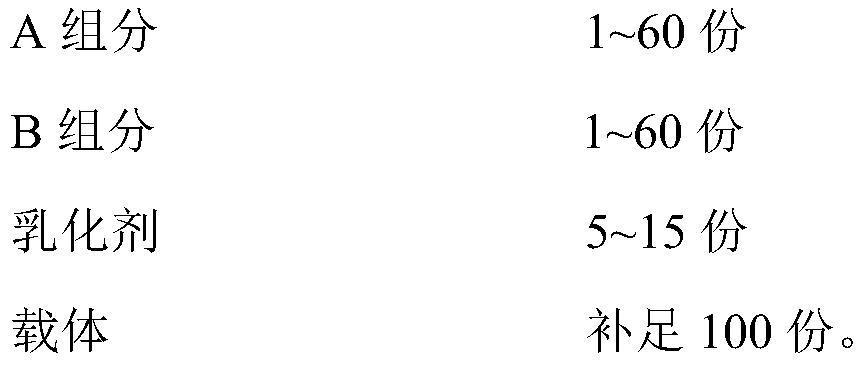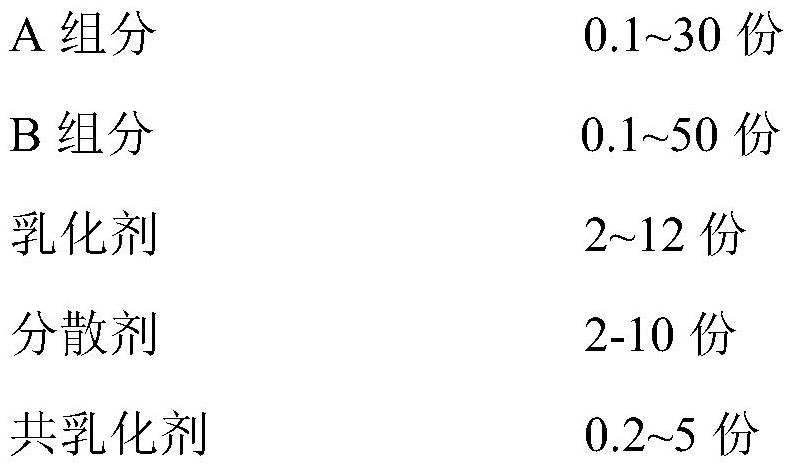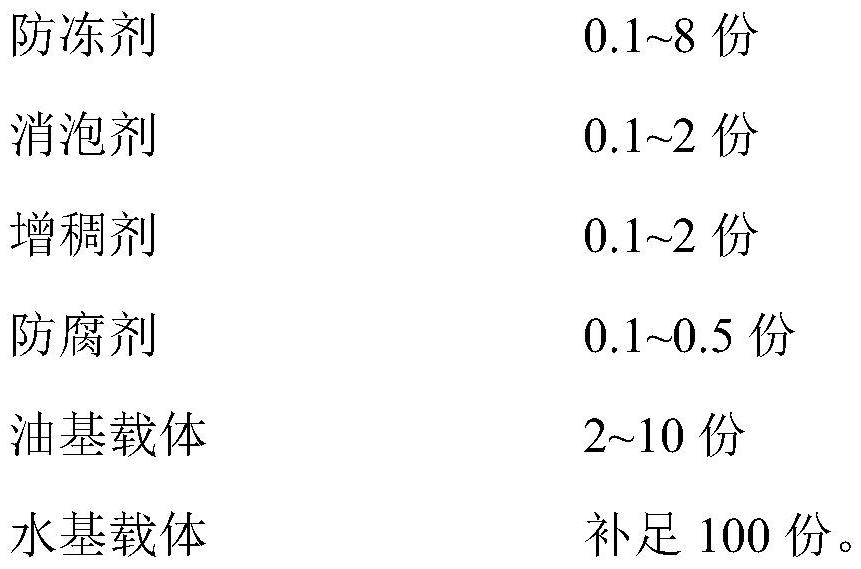Insecticidal composition and application thereof in pest control
A pesticidal composition and technology for controlling pests, applied in the fields of application, pesticides, biocides, etc., can solve the problems of few types of pests and single application method
- Summary
- Abstract
- Description
- Claims
- Application Information
AI Technical Summary
Problems solved by technology
Method used
Image
Examples
Embodiment 1
[0061] Calculate the toxicity index and co-toxicity coefficient (CTC) of the drug by calculating the co-toxicity coefficient of the compound according to the toxicity index.
[0062]
[0063] Theoretical toxicity index (TTI) = ∑ (the toxicity index TI of each single agent × the percentage of single agent in the mixture)
[0064]
[0065] Experimental judgment basis:
[0066] When CTC≤80, the composition exhibits antagonistic effect; when 80
[0067] Mix 2-chloro-6-((4-phenoxyphenoxy)methyl)pyridine and bifenthrin according to the weight ratio of 80:1 to 1:80 to obtain various compositions, select several specific ones The composition corresponding to the weight ratio measures its toxicity to cotton aphids, and the test results are shown in Table 1:
[0068] Table 1 Comparison of toxicity test results against cotton aphids
[0069]
[0070]
[0071] Analy...
Embodiment 2
[0079] Experimental effect calculation method and experimental judgment basis: the same as in Example 1.
[0080] Mix 2-chloro-6-((4-phenoxyphenoxy)methyl)pyridine and bifenthrin according to the weight ratio of 80:1 to 1:80 to obtain various compositions, select several specific ones The composition corresponding to the weight ratio measures its toxicity to armyworm, and test result is as shown in table 2:
[0081] Table 2 Comparison of toxicity test results against armyworm
[0082]
[0083] Analysis of experimental results: It can be seen from Table 2 that:
[0084] 1) 2-Chloro-6-((4-phenoxyphenoxy)methyl)pyridine and bifenthrin have high measured toxicity index (ATI) in the weight range of 20:1-1:80 in toxicity index (TTI). Especially in the weight ratio range of 2-chloro-6-((4-phenoxyphenoxy)methyl)pyridine and bifenthrin in the range of 3:1-1:40, the ATI is much higher than the TTI, indicating that the increase The effect is obvious.
[0085] 2) 2-chloro-6-((4-ph...
Embodiment 3
[0091] Experimental effect calculation method and experimental judgment basis: the same as in Example 1.
[0092] Mix 2-chloro-6-((4-phenoxyphenoxy)methyl)pyridine and bifenthrin according to the weight ratio of 80:1 to 1:80 to obtain various compositions, select several specific ones The composition corresponding to the weight ratio measures its toxicity to diamondback moth, and the test results are as shown in table 3:
[0093] Table 3 Comparison of the toxicity test results of diamondback moth
[0094]
[0095] Analysis of experimental results: It can be seen from Table 3 that:
[0096] 1) 2-Chloro-6-((4-phenoxyphenoxy)methyl)pyridine and bifenthrin have high measured toxicity index (ATI) in the weight range of 20:1-1:80 in toxicity index (TTI). Especially in the weight ratio range of 2-chloro-6-((4-phenoxyphenoxy)methyl)pyridine and bifenthrin in the range of 3:1-1:40, the ATI is much higher than the TTI, indicating that the increase The effect is obvious.
[0097]...
PUM
 Login to View More
Login to View More Abstract
Description
Claims
Application Information
 Login to View More
Login to View More - R&D
- Intellectual Property
- Life Sciences
- Materials
- Tech Scout
- Unparalleled Data Quality
- Higher Quality Content
- 60% Fewer Hallucinations
Browse by: Latest US Patents, China's latest patents, Technical Efficacy Thesaurus, Application Domain, Technology Topic, Popular Technical Reports.
© 2025 PatSnap. All rights reserved.Legal|Privacy policy|Modern Slavery Act Transparency Statement|Sitemap|About US| Contact US: help@patsnap.com



